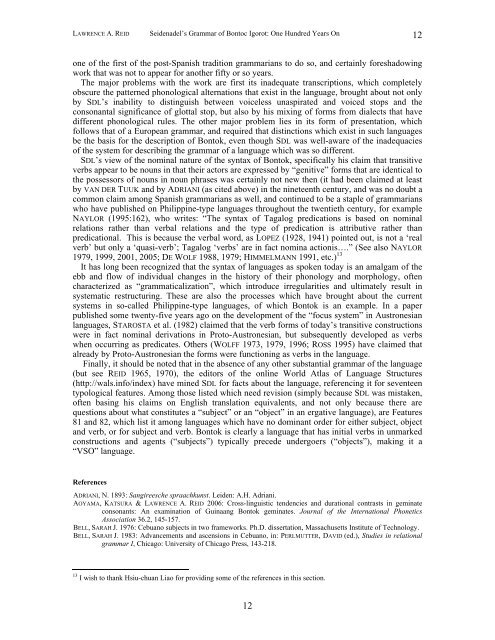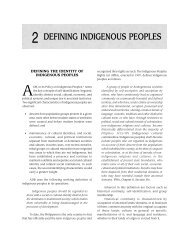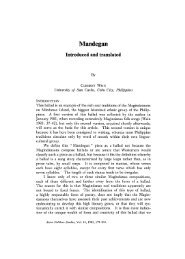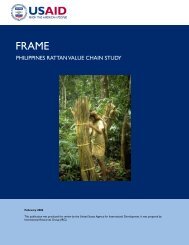1 Seidenadel's Grammar of Bontoc Igorot: One Hundred Years On
1 Seidenadel's Grammar of Bontoc Igorot: One Hundred Years On
1 Seidenadel's Grammar of Bontoc Igorot: One Hundred Years On
- No tags were found...
Create successful ePaper yourself
Turn your PDF publications into a flip-book with our unique Google optimized e-Paper software.
LAWRENCE A. REID Seidenadel’s <strong>Grammar</strong> <strong>of</strong> <strong>Bontoc</strong> <strong>Igorot</strong>: <strong><strong>On</strong>e</strong> <strong>Hundred</strong> <strong>Years</strong> <strong>On</strong> 12<br />
one <strong>of</strong> the first <strong>of</strong> the post-Spanish tradition grammarians to do so, and certainly foreshadowing<br />
work that was not to appear for another fifty or so years.<br />
The major problems with the work are first its inadequate transcriptions, which completely<br />
obscure the patterned phonological alternations that exist in the language, brought about not only<br />
by SDL’s inability to distinguish between voiceless unaspirated and voiced stops and the<br />
consonantal significance <strong>of</strong> glottal stop, but also by his mixing <strong>of</strong> forms from dialects that have<br />
different phonological rules. The other major problem lies in its form <strong>of</strong> presentation, which<br />
follows that <strong>of</strong> a European grammar, and required that distinctions which exist in such languages<br />
be the basis for the description <strong>of</strong> Bontok, even though SDL was well-aware <strong>of</strong> the inadequacies<br />
<strong>of</strong> the system for describing the grammar <strong>of</strong> a language which was so different.<br />
SDL’s view <strong>of</strong> the nominal nature <strong>of</strong> the syntax <strong>of</strong> Bontok, specifically his claim that transitive<br />
verbs appear to be nouns in that their actors are expressed by “genitive” forms that are identical to<br />
the possessors <strong>of</strong> nouns in noun phrases was certainly not new then (it had been claimed at least<br />
by VAN DER TUUK and by ADRIANI (as cited above) in the nineteenth century, and was no doubt a<br />
common claim among Spanish grammarians as well, and continued to be a staple <strong>of</strong> grammarians<br />
who have published on Philippine-type languages throughout the twentieth century, for example<br />
NAYLOR (1995:162), who writes: “The syntax <strong>of</strong> Tagalog predications is based on nominal<br />
relations rather than verbal relations and the type <strong>of</strong> predication is attributive rather than<br />
predicational. This is because the verbal word, as LOPEZ (1928, 1941) pointed out, is not a ‘real<br />
verb’ but only a ‘quasi-verb’; Tagalog ‘verbs’ are in fact nomina actionis….” (See also NAYLOR<br />
1979, 1999, 2001, 2005; DE WOLF 1988, 1979; HIMMELMANN 1991, etc.) 13<br />
It has long been recognized that the syntax <strong>of</strong> languages as spoken today is an amalgam <strong>of</strong> the<br />
ebb and flow <strong>of</strong> individual changes in the history <strong>of</strong> their phonology and morphology, <strong>of</strong>ten<br />
characterized as “grammaticalization”, which introduce irregularities and ultimately result in<br />
systematic restructuring. These are also the processes which have brought about the current<br />
systems in so-called Philippine-type languages, <strong>of</strong> which Bontok is an example. In a paper<br />
published some twenty-five years ago on the development <strong>of</strong> the “focus system” in Austronesian<br />
languages, STAROSTA et al. (1982) claimed that the verb forms <strong>of</strong> today’s transitive constructions<br />
were in fact nominal derivations in Proto-Austronesian, but subsequently developed as verbs<br />
when occurring as predicates. Others (WOLFF 1973, 1979, 1996; ROSS 1995) have claimed that<br />
already by Proto-Austronesian the forms were functioning as verbs in the language.<br />
Finally, it should be noted that in the absence <strong>of</strong> any other substantial grammar <strong>of</strong> the language<br />
(but see REID 1965, 1970), the editors <strong>of</strong> the online World Atlas <strong>of</strong> Language Structures<br />
(http://wals.info/index) have mined SDL for facts about the language, referencing it for seventeen<br />
typological features. Among those listed which need revision (simply because SDL was mistaken,<br />
<strong>of</strong>ten basing his claims on English translation equivalents, and not only because there are<br />
questions about what constitutes a “subject” or an “object” in an ergative language), are Features<br />
81 and 82, which list it among languages which have no dominant order for either subject, object<br />
and verb, or for subject and verb. Bontok is clearly a language that has initial verbs in unmarked<br />
constructions and agents (“subjects”) typically precede undergoers (“objects”), making it a<br />
“VSO” language.<br />
References<br />
ADRIANI, N. 1893: Sangireesche spraachkunst. Leiden: A.H. Adriani.<br />
AOYAMA, KATSURA & LAWRENCE A. REID 2006: Cross-linguistic tendencies and durational contrasts in geminate<br />
consonants: An examination <strong>of</strong> Guinaang Bontok geminates. Journal <strong>of</strong> the International Phonetics<br />
Association 36.2, 145-157.<br />
BELL, SARAH J. 1976: Cebuano subjects in two frameworks. Ph.D. dissertation, Massachusetts Institute <strong>of</strong> Technology.<br />
BELL, SARAH J. 1983: Advancements and ascensions in Cebuano, in: PERLMUTTER, DAVID (ed.), Studies in relational<br />
grammar I, Chicago: University <strong>of</strong> Chicago Press, 143-218.<br />
13 I wish to thank Hsiu-chuan Liao for providing some <strong>of</strong> the references in this section.<br />
12

















